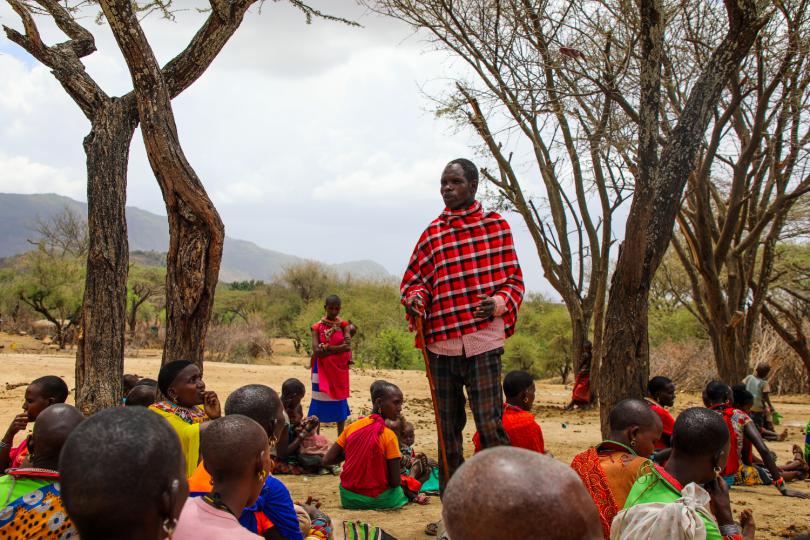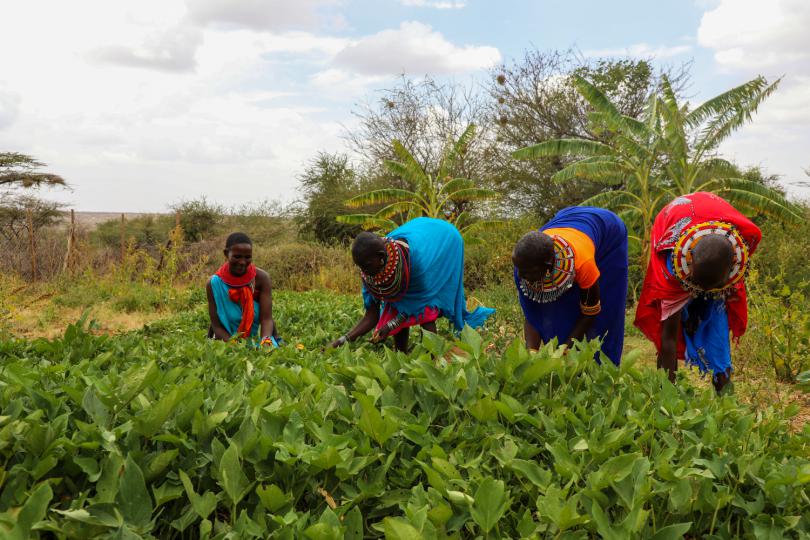IMPROVING MATERNAL AND CHILD HEALTH: COMMUNITY HEALTH INITIATIVES IN SAMBURU NORTH

Jacob visits a lactating mother in her newly established kitchen garden. Photo Courtesy| Dorothy Waweru, Save the Children
By Dorothy Waweru
Antenatal care for pregnant women in one of the villages in Samburu North sub-county was a matter lightly taken by most women. In addition, a myth that children would get sick after vaccination was deeply held by a majority of the mothers owing to the side effects such as fevers and crying that would be exhibited by children after vaccination. These and many more were among the factors that motivated Joseph Lenengwesi and Jacob Leipele to become Community Health Promoters overseeing over 30 households.
“My community is pastoral and women sometimes are likely to miss their clinics. I volunteered to become a CHP so that I can pass knowledge to mothers on the importance of attending all the clinics. At first, it was an uphill task to change the mindset of the people on the importance of taking care of their health but with time their perception started to change,” says Jacob.
In retrospection, Jacob says that the Mercy Corps-led USAID Nawiri project boosted his knowledge as a CHP enabling him to extend his duties with confidence. Some of the trainings he received include how to interact with the community, Community Health Unit Savings and Loanings Association (CHUSLA), and Integrated Community Case Management (ICCM) among others. The community members have come to accept the teachings they are receiving from the CHPs as a result of sensitization on the USAID Nawiri project. One of the outstanding successes, Jacob recalls is a time when a mother who was due to deliver came to him for guidance.
“I was very shocked because in my community women would previously give birth at home but this one came for a referral note to go to the health facility. When she delivered after sometimes she reported to me that delivering at the hospital is good because the health care workers treated her well and even ensured that she started to feed while in hospital. Culturally women in Samburu would not eat solid food after delivery, they would take liquids for up to about one month believing that if they take anything else their stomach would be affected,” says Jacob.

Joseph holding a health talk with women in his community. Photo Courtesy| Save the Children
For Joseph, through the Mercy Corps-led consortium, Save the Children officers enabled him to train the community members on hygiene promotion and even business skills. He also adds that the project also registered households with children who had malnutrition into a cash transfer program.
“The cash transfer helped our community so much. Parents who would trek for long distances in search of food now can buy food closer to their homes and the health of the children has improved and it is hard to get a child with severe acute malnutrition. People have even bought chicken and goats with the money they received and they have learnt how to save money. Our community did not know anything about saving money but now they are educated on the importance of savings,” says Joseph.
Joseph says that USAID Nawiri has opened the community’s eyes and brains to think about farming of vegetables and almost every household has a kitchen garden. Families now eat green leafy vegetables, tomatoes, pumpkin, sweet potatoes, and more healthy foods.

Part of the Simale Adapted Mother-to-Mother Support Group tending their vegetable garden. Photo Courtesy| Dorothy Waweru, Save the Children
“Previously, we did not know that food would come out of the soil we just relied on herding goats and cows but now we value farming like our livestock. I urge USAID Nawiri to continue supporting us to learn many more things, “says Joseph.
Lesuuda Lmeriai, Health and Nutrition Coordinator in the USAID Nawiri project says that one of the greatest achievement in the implementation of the health component has been to see the change in behavior of the targeted communities.
“I have seen families now embracing food such as eggs and chicken meat which previously were not consumed by a majority of the community members. People have also learnt the importance of green leafy vegetables such as kales and this has contributed to the reduction of persistent acute malnutrition,” says Lesuuda.
USAID Nawiri programme is keen to ensure the reduction of persistent acute malnutrition in Turkana and Samburu counties. Through the programme, there has been a deliberate effort to intensify access to quality health and nutrition services through anchor groups reaching communities in remote areas. The formation of the anchor groups which include Adapted Mother to Mother Support Groups, Girl and boy groups have made it possible to carry out community growth monitoring, screening for acute malnutrition, family planning service delivery, and the strengthening of referrals. The Programme has also supported integrated health and nutrition outreaches enabling the easy access of services. This layered approach has improved and enhanced community and health care workers interactions.




